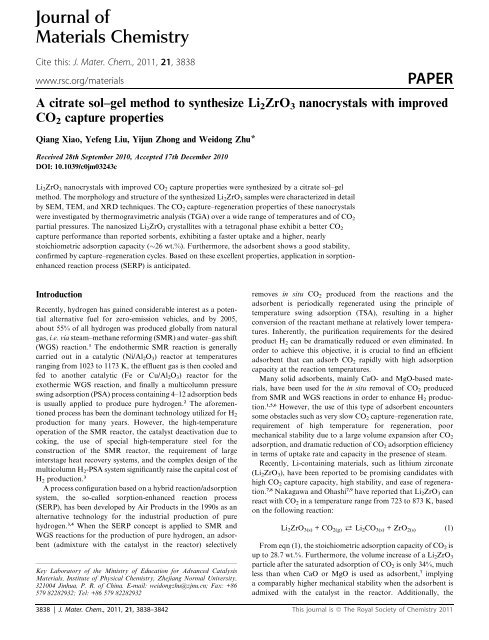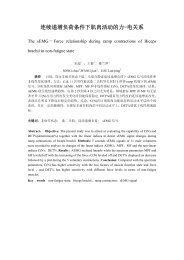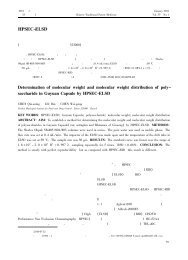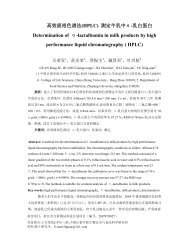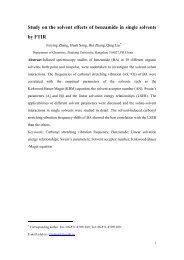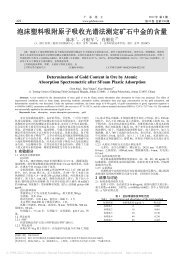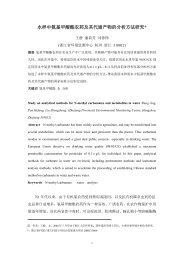Journal of Materials Chemistry PAPER
Journal of Materials Chemistry PAPER
Journal of Materials Chemistry PAPER
You also want an ePaper? Increase the reach of your titles
YUMPU automatically turns print PDFs into web optimized ePapers that Google loves.
<strong>Journal</strong> <strong>of</strong><br />
<strong>Materials</strong> <strong>Chemistry</strong><br />
Cite this: J. Mater. Chem., 2011, 21, 3838<br />
www.rsc.org/materials<br />
A citrate sol–gel method to synthesize Li 2 ZrO 3 nanocrystals with improved<br />
CO 2 capture properties<br />
Qiang Xiao, Yefeng Liu, Yijun Zhong and Weidong Zhu*<br />
Received 28th September 2010, Accepted 17th December 2010<br />
DOI: 10.1039/c0jm03243c<br />
<strong>PAPER</strong><br />
Li 2 ZrO 3 nanocrystals with improved CO 2 capture properties were synthesized by a citrate sol–gel<br />
method. The morphology and structure <strong>of</strong> the synthesized Li 2 ZrO 3 samples were characterized in detail<br />
by SEM, TEM, and XRD techniques. The CO 2 capture–regeneration properties <strong>of</strong> these nanocrystals<br />
were investigated by thermogravimetric analysis (TGA) over a wide range <strong>of</strong> temperatures and <strong>of</strong> CO 2<br />
partial pressures. The nanosized Li 2 ZrO 3 crystallites with a tetragonal phase exhibit a better CO 2<br />
capture performance than reported sorbents, exhibiting a faster uptake and a higher, nearly<br />
stoichiometric adsorption capacity (26 wt.%). Furthermore, the adsorbent shows a good stability,<br />
confirmed by capture–regeneration cycles. Based on these excellent properties, application in sorptionenhanced<br />
reaction process (SERP) is anticipated.<br />
Introduction<br />
Recently, hydrogen has gained considerable interest as a potential<br />
alternative fuel for zero-emission vehicles, and by 2005,<br />
about 55% <strong>of</strong> all hydrogen was produced globally from natural<br />
gas, i.e. via steam–methane reforming (SMR) and water–gas shift<br />
(WGS) reaction. 1 The endothermic SMR reaction is generally<br />
carried out in a catalytic (Ni/Al 2 O 3 ) reactor at temperatures<br />
ranging from 1023 to 1173 K, the effluent gas is then cooled and<br />
fed to another catalytic (Fe or Cu/Al 2 O 3 ) reactor for the<br />
exothermic WGS reaction, and finally a multicolumn pressure<br />
swing adsorption (PSA) process containing 4–12 adsorption beds<br />
is usually applied to produce pure hydrogen. 2 The aforementioned<br />
process has been the dominant technology utilized for H 2<br />
production for many years. However, the high-temperature<br />
operation <strong>of</strong> the SMR reactor, the catalyst deactivation due to<br />
coking, the use <strong>of</strong> special high-temperature steel for the<br />
construction <strong>of</strong> the SMR reactor, the requirement <strong>of</strong> large<br />
interstage heat recovery systems, and the complex design <strong>of</strong> the<br />
multicolumn H 2 -PSA system significantly raise the capital cost <strong>of</strong><br />
H 2 production. 3<br />
A process configuration based on a hybrid reaction/adsorption<br />
system, the so-called sorption-enhanced reaction process<br />
(SERP), has been developed by Air Products in the 1990s as an<br />
alternative technology for the industrial production <strong>of</strong> pure<br />
hydrogen. 3,4 When the SERP concept is applied to SMR and<br />
WGS reactions for the production <strong>of</strong> pure hydrogen, an adsorbent<br />
(admixture with the catalyst in the reactor) selectively<br />
Key Laboratory <strong>of</strong> the Ministry <strong>of</strong> Education for Advanced Catalysis<br />
<strong>Materials</strong>, Institute <strong>of</strong> Physical <strong>Chemistry</strong>, Zhejiang Normal University,<br />
321004 Jinhua, P. R. <strong>of</strong> China. E-mail: weidongzhu@zjnu.cn; Fax: +86<br />
579 82282932; Tel: +86 579 82282932<br />
removes in situ CO 2 produced from the reactions and the<br />
adsorbent is periodically regenerated using the principle <strong>of</strong><br />
temperature swing adsorption (TSA), resulting in a higher<br />
conversion <strong>of</strong> the reactant methane at relatively lower temperatures.<br />
Inherently, the purification requirements for the desired<br />
product H 2 can be dramatically reduced or even eliminated. In<br />
order to achieve this objective, it is crucial to find an efficient<br />
adsorbent that can adsorb CO 2 rapidly with high adsorption<br />
capacity at the reaction temperatures.<br />
Many solid adsorbents, mainly CaO- and MgO-based materials,<br />
have been used for the in situ removal <strong>of</strong> CO 2 produced<br />
from SMR and WGS reactions in order to enhance H 2 production.<br />
1,5,6 However, the use <strong>of</strong> this type <strong>of</strong> adsorbent encounters<br />
some obstacles such as very slow CO 2 capture–regeneration rate,<br />
requirement <strong>of</strong> high temperature for regeneration, poor<br />
mechanical stability due to a large volume expansion after CO 2<br />
adsorption, and dramatic reduction <strong>of</strong> CO 2 adsorption efficiency<br />
in terms <strong>of</strong> uptake rate and capacity in the presence <strong>of</strong> steam.<br />
Recently, Li-containing materials, such as lithium zirconate<br />
(Li 2 ZrO 3 ), have been reported to be promising candidates with<br />
high CO 2 capture capacity, high stability, and ease <strong>of</strong> regeneration.<br />
7,8 Nakagawa and Ohashi 7,9 have reported that Li 2 ZrO 3 can<br />
react with CO 2 in a temperature range from 723 to 873 K, based<br />
on the following reaction:<br />
Li 2 ZrO 3(s) +CO 2(g) % Li 2 CO 3(s) + ZrO 2(s) (1)<br />
From eqn (1), the stoichiometric adsorption capacity <strong>of</strong> CO 2 is<br />
up to 28.7 wt.%. Furthermore, the volume increase <strong>of</strong> a Li 2 ZrO 3<br />
particle after the saturated adsorption <strong>of</strong> CO 2 is only 34%, much<br />
less than when CaO or MgO is used as adsorbent, 7 implying<br />
a comparably higher mechanical stability when the adsorbent is<br />
admixed with the catalyst in the reactor. Additionally, the<br />
3838 | J. Mater. Chem., 2011, 21, 3838–3842 This journal is ª The Royal Society <strong>of</strong> <strong>Chemistry</strong> 2011
temperature for the regeneration <strong>of</strong> CO 2 -adsorbed Li 2 ZrO 3 is<br />
much lower, and the presence <strong>of</strong> steam can improve the CO 2<br />
capture properties <strong>of</strong> Li 2 ZrO 3 . 10 These merits <strong>of</strong> Li 2 ZrO 3 lead to<br />
its applicability as an adsorbent for the in situ removal <strong>of</strong> CO 2<br />
produced from SMR and WGS reactions to enhance H 2<br />
productivity. 9<br />
Various solid-state synthetic methods have been used to<br />
prepare Li 2 ZrO 3 powder. 7,11 In a solid-state process, starting<br />
materials, usually ZrO 2 and Li 2 CO 3 , are mechanically mixed and<br />
heated at high temperatures for a long time. Consequently, sintering<br />
at high temperatures results in large particle sizes <strong>of</strong> the<br />
resulting Li 2 ZrO 3 . Meanwhile, the sublimation <strong>of</strong> Li 2 O cannot<br />
be avoided due to high-temperature calcination. These aspects<br />
lead to poor CO 2 adsorption properties <strong>of</strong> the Li 2 ZrO 3 powder<br />
prepared by the solid-state method. Nair et al. 11 pointed out that<br />
the smaller the size <strong>of</strong> Li 2 ZrO 3 particles, the faster their CO 2<br />
uptake. In addition, Lin’s group 12,13 proposed a ‘double-shell’<br />
model for CO 2 adsorption in Li 2 ZrO 3 , which indicates that<br />
Li 2 ZrO 3 <strong>of</strong> a smaller particle size shows a faster CO 2 uptake.<br />
In order to prepare Li 2 ZrO 3 with a fine particle size, a liquidphase<br />
method was proposed by Yi and Eriksen. 14 A dramatic<br />
improvement <strong>of</strong> CO 2 adsorption efficiency in the Li 2 ZrO 3<br />
particles prepared by the liquid-phase method was observed,<br />
yielding a higher capacity and about ten times faster uptake.<br />
Later, Chen and coworkers 15,16 reported a modified liquid-phase<br />
method to prepare nanocrystalline Li 2 ZrO 3 , in which soluble Zr<br />
and Li compounds were used as raw materials to obtain<br />
a complex solution containing Zr and Li precursors with<br />
appropriate amounts, and then the solution was spray dried to<br />
form Li 2 ZrO 3 powder. After calcination, the obtained nanocrystalline<br />
Li 2 ZrO 3 showed a better uptake for CO 2 under the<br />
applied conditions.<br />
Although Li 2 ZrO 3 prepared by the liquid-phase method exhibits<br />
a faster uptake, compared to those synthesized by the solid-state<br />
method, the uptake <strong>of</strong> CO 2 is still slow, especially for the case at<br />
CO 2 partial pressures below 0.5 bar. Furthermore, the adsorption<br />
<strong>of</strong> CO 2 hardly reaches its stoichiometric adsorption capacity. It<br />
should be noted that in the liquid-phase procedure soluble Li and<br />
Zr salts are dissolved together, followed by evaporation <strong>of</strong> the<br />
solvent to form a solid mixture containing Li and Zr species.<br />
Differences in the solubility <strong>of</strong> each component would result in<br />
a heterogeneous distribution <strong>of</strong> Li and Zr species. Consequently,<br />
the heterogeneity <strong>of</strong> their spatial distribution would bring forth an<br />
incomplete formation <strong>of</strong> the Li 2 ZrO 3 phase after calcination.<br />
Therefore, the Li 2 ZrO 3 adsorbents prepared by this liquid-phase<br />
method could not possess the desired CO 2 capture properties.<br />
The citrate sol–gel method was first proposed by Pechini 17 for<br />
preparing ABO 3 -perovskite type powders. The typical synthesis<br />
procedure is described as follows: metallic ions and citrate form<br />
complex anions at first and then a sol forms by the polymerization<br />
<strong>of</strong> citrate in glycol. After the evaporation <strong>of</strong> solvent, a gel<br />
comes into being, during which multi-metallic components are<br />
confined in the gel net. After the removal <strong>of</strong> the organic gel by<br />
calcination, a fine powder <strong>of</strong> desired stoichiometric composition<br />
can be obtained. Subsequently, Choy and Han 18 developed<br />
a modified citrate sol–gel method, in which water was used<br />
instead <strong>of</strong> glycol. The citrate sol–gel method is now a common<br />
approach for the synthesis <strong>of</strong> ABO 3 -type nanocrystals. Although<br />
the synthesis <strong>of</strong> ABO 3 -type powders such as Pb(Zr,Ti)O 3 oxides<br />
etc. via the citrate (or modified) sol–gel method has been intensively<br />
investigated, the synthesis <strong>of</strong> Li 2 ZrO 3 nanocrystals via this<br />
method is rarely reported.<br />
In the present work, a citrate sol–gel method has been used to<br />
synthesize Li 2 ZrO 3 nanocrystals. The CO 2 capture–regeneration<br />
properties <strong>of</strong> the synthesized nanocrystals have been investigated<br />
over a wide range <strong>of</strong> CO 2 pressures at different temperatures by<br />
thermogravimetric analysis (TGA).<br />
Experimental<br />
Chemicals<br />
Zirconium oxynitrate [ZrO(NO 3 ) 2 $2H 2 O] was purchased from<br />
Tianjin Guangfu Fine Chemical Research Institute. Lithium<br />
nitrate (LiNO 3 ) was purchased from Shanghai Shanpu Chemical<br />
Co., Ltd. Citric acid (CA, C 6 H 8 O 7 $H 2 O) and urea [CO(NH 2 ) 2 ]<br />
were purchased from Shantou Xilong Chemical Factory. All the<br />
reagents were analytical grade and used as received without<br />
further purification. The deionized water was obtained from<br />
Millipore Milli-QÒ ultrapure water purification systems with<br />
a resistivity greater than 18.2 MU.<br />
Syntheses<br />
In a typical citrate sol–gel synthesis, 2.67 g ZrO(NO 3 ) 2 $2H 2 O,<br />
1.38 g LiNO 3 , 6.30 g CA, and 3.00 g urea were dissolved in 46 ml<br />
deionized water. The solution was heated to 343 K and aged for 6<br />
h with stirring and then was exposed to air to evaporate the<br />
solvent until a gel was formed. The resulting gel was dried at 393<br />
K in an oven overnight, and the formed solid is referred to as the<br />
as-obtained sample. The as-obtained powder was put into<br />
a dense alumina crucible in a furnace box where the temperature<br />
was first increased to 673 K at a rate <strong>of</strong> 1 K min :1 and then<br />
maintained at 673 K in stagnant air for 2 h. Afterwards the<br />
temperature was further increased to 923 K at a rate <strong>of</strong> 1 K min :1<br />
and maintained for 6 h. After being cooled down to room<br />
temperature, the final white powder was obtained.<br />
For comparison, Li 2 ZrO 3 particles were synthesized by<br />
coprecipitation and liquid-phase methods. In a coprecipitation<br />
synthesis, the dose and addition order <strong>of</strong> the raw materials and<br />
the heat treatment that followed were the same as those in the<br />
sol–gel synthesis, except that no citric acid was used. In a liquidphase<br />
method, neither citric acid nor urea was used. The samples<br />
prepared by the citrate sol–gel, coprecipitation, and liquid-phase<br />
methods are referred to as LZ-sg, LZ-co, and LZ-lp, respectively.<br />
Characterization<br />
The X-ray diffraction patterns were recorded on a Philips<br />
PW3040/60 diffractometer using CuKa radiation (l ¼ 1.54 A).<br />
The scans were recorded in the 2q range between 10 and 90 with<br />
a step width <strong>of</strong> 0.03 . The average crystallite size <strong>of</strong> powder was<br />
calculated using Scherrer’s equation from the width <strong>of</strong> the<br />
reflection peak located at 2q ¼ 42.3 . Silicon standard, Si, was<br />
used as reference material to determine the instrumental line<br />
broadening.<br />
The scanning electron microscope (SEM) observations were<br />
performed on a Hitachi S-4800 apparatus equipped with a field<br />
emission gun. The acceleration voltage was set to 5 kV. The<br />
This journal is ª The Royal Society <strong>of</strong> <strong>Chemistry</strong> 2011 J. Mater. Chem., 2011, 21, 3838–3842 | 3839
sample was stuck on the observation platform and sprayed with<br />
gold vapor under high vacuum for about 20 s. The transmission<br />
electron microscopy (TEM) observations were carried out on<br />
a Philips Tecnai F20 transmission electron microscope working<br />
at 200 kV. The sample was diluted in ethanol to give a 1 : 5<br />
volume ratio, and sonicated for 10 min. The ethanol slurry was<br />
then dripped onto a Cu grid covered with a thin film <strong>of</strong> carbon.<br />
The TGA-DTA experiments with ca. 15 mg <strong>of</strong> the as-obtained<br />
samples were carried out on a NETZSCH STA449 thermogravimetric<br />
analyzer with a heating rate <strong>of</strong> 20 K min :1 in an air flow<br />
<strong>of</strong> 40 ml min :1 .<br />
CO 2 adsorption<br />
The adsorption <strong>of</strong> CO 2 in the synthesized Li 2 ZrO 3 nanocrystals<br />
was studied on a thermogravimetric analyzer (NETZSCH<br />
STA449). The sample cell (a dense alumina crucible pot) was<br />
loaded with ca. 15 mg <strong>of</strong> adsorbent. Prior to the CO 2 adsorption<br />
experiments, the adsorbent was heated up to the desired<br />
temperature (823 K or 773 K) at a rate <strong>of</strong> 10 K min :1 in<br />
a nitrogen flow <strong>of</strong> 40 ml min :1 , during which the adsorbed<br />
impurities in the sample were removed. Then, the N 2 flow was<br />
switched to a mixture flow containing CO 2 and N 2 or to a pure<br />
CO 2 flow for adsorption, all at 1 bar. The partial pressure <strong>of</strong> CO 2<br />
was determined by its fraction <strong>of</strong> the total feed flow rate and the<br />
total pressure. The total feed flow was always set at 40 ml min :1 .<br />
The adsorption <strong>of</strong> CO 2 was carried out for 60 min, referred to as<br />
period I. Afterwards, the feed gas stream was switched to a pure<br />
N 2 flow <strong>of</strong> 40 ml min :1 and the temperature was raised at a rate <strong>of</strong><br />
10 K min :1 to 923 K, maintaining this temperature for 50 min.<br />
This desorption (regeneration) process lasted 60 min, referred to<br />
as period II. The combined period I and period II is defined as<br />
one adsorption–desorption (capture–regeneration) cycle. To<br />
correct for the weight change caused by the change in the density<br />
<strong>of</strong> the gas phase, blank experiments were performed. In a blank<br />
experiment the TGA response was measured with the empty<br />
dense alumina crucible pot used.<br />
Results and discussion<br />
The as-obtained sample prepared via the citrate sol–gel method<br />
contains a large amount <strong>of</strong> organic species. As shown in the TGA<br />
curve (Fig. 1), a decrease <strong>of</strong> 85% by weight can be seen in the<br />
range from 298 to 1123 K. The whole weight loss process can be<br />
divided into two stages. The first with a weight loss <strong>of</strong> 55%<br />
accompanied with a broad endothermic peak at temperatures<br />
between 298 and 533 K should be attributed to the desorption or<br />
decomposition <strong>of</strong> the organic species, partially from the citrate<br />
precursor. 19 The second stage with a weight loss <strong>of</strong> ca. 30% starts<br />
at 673 K and an exothermic peak around 847 K can be observed<br />
in the DTA curve, corresponding to the drastic combustion <strong>of</strong><br />
the organic species in the sample. The weight stays constant at<br />
temperatures over 923 K, which is much lower than those (ca.<br />
1273 K) required for preparing Li 2 ZrO 3 powder via the solidstate<br />
reaction method. 7<br />
The adsorption and desorption pr<strong>of</strong>ile <strong>of</strong> CO 2 in the Li 2 ZrO 3<br />
adsorbent prepared via the citrate sol–gel method is shown as<br />
curve a in Fig. 2. At 823 K and a CO 2 partial pressure <strong>of</strong> 0.5 bar,<br />
the uptake <strong>of</strong> CO 2 reaches 26 wt.% within 20 min, which is about<br />
90% <strong>of</strong> the stoichiometric adsorption capacity <strong>of</strong> CO 2 in Li 2 ZrO 3<br />
(28.7 wt.%). Additionally, the desorption in flowing N 2 is also<br />
fast and the complete desorption takes less than 20 min. To<br />
illustrate the role <strong>of</strong> citric acid in the synthesis <strong>of</strong> Li 2 ZrO 3 , two<br />
samples without the use <strong>of</strong> citric acid have been synthesized for<br />
comparison. The adsorption and desorption pr<strong>of</strong>iles <strong>of</strong> CO 2 in<br />
these two samples are also shown in Fig. 2. The Li 2 ZrO 3 sample<br />
prepared by the liquid-phase method, i.e. LZ-lp, displays the<br />
lowest CO 2 uptake rate under the investigated conditions, see<br />
curve c in Fig. 2. Although the Li 2 ZrO 3 sample prepared by the<br />
coprecipitation method, i.e. LZ-co, shows some improved CO 2<br />
capture properties in comparison with LZ-lp, its CO 2 uptake is<br />
still slower, compared to that in the Li 2 ZrO 3 sample prepared by<br />
the sol–gel method, i.e. LZ-sg. These results clearly show that<br />
LZ-sg has the best CO 2 capture properties.<br />
It has been reported that the crystallite phase <strong>of</strong> Li 2 ZrO 3 can<br />
have a great influence on CO 2 capture properties. 11 Fig. 3 shows the<br />
XRD patterns <strong>of</strong> the Li 2 ZrO 3 samples prepared by the aforementioned<br />
three methods, indicating that both tetragonal and<br />
monoclinic crystallite phases are present in all samples. However,<br />
as shown in Fig. 3, the crystallite phase <strong>of</strong> LZ-sg is mainly<br />
tetragonal. Nair et al. 11 reported that Li 2 ZrO 3 crystallites with<br />
a tetragonal phase showed better CO 2 -capture properties in terms<br />
<strong>of</strong> uptake rate than those with a monoclinic phase. The current<br />
results are in agreement with this observation from the literature.<br />
Fig. 1 TGA and DTA curves <strong>of</strong> the as-obtained sample synthesized via<br />
the citrate sol–gel method with a heating rate <strong>of</strong> 20 K min :1 in an air flow<br />
<strong>of</strong> 40 ml min :1 .<br />
Fig. 2 Adsorption and desorption pr<strong>of</strong>iles <strong>of</strong> CO 2 for three different<br />
Li 2 ZrO 3 samples. (a) LZ-sg, (b) LZ-co, (c) LZ-lp; (I) adsorption at 823 K<br />
and a CO 2 partial pressure <strong>of</strong> 0.5 bar, (II) desorption by heating (10 K<br />
min :1 ) to 923 K in a pure N 2 flow <strong>of</strong> 40 ml min :1 .<br />
3840 | J. Mater. Chem., 2011, 21, 3838–3842 This journal is ª The Royal Society <strong>of</strong> <strong>Chemistry</strong> 2011
Fig. 3 XRD patterns <strong>of</strong> three different Li 2 ZrO 3 samples. (a) LZ-sg, (b)<br />
LZ-co, (c) LZ-lp.<br />
The uptake rate <strong>of</strong> CO 2 should be also related to the crystallite<br />
size <strong>of</strong> Li 2 ZrO 3 . The crystallite sizes <strong>of</strong> the three different<br />
samples, estimated from the XRD data using Scherrer’s equation,<br />
are 17, 26, and 34 nm for LZ-sg, LZ-co, and LZ-lp,<br />
respectively. It is logical from an engineering point <strong>of</strong> view that<br />
the smaller the size <strong>of</strong> Li 2 ZrO 3 crystals, the faster the CO 2 uptake<br />
in case <strong>of</strong> a diffusion limited process.<br />
The stability <strong>of</strong> an adsorbent is crucial when applied to the in<br />
situ removal <strong>of</strong> CO 2 produced in some reactions such as steam–<br />
methane reforming (SMR) and water–gas shift (WGS) reaction<br />
to enhance hydrogen production as well as in the separation <strong>of</strong><br />
CO 2 from fuel-fired power stations at high temperatures.<br />
Therefore, the stability <strong>of</strong> LZ-sg was investigated by TGA. Fig. 4<br />
shows three CO 2 capture–regeneration cycles, indicating an<br />
excellent stability <strong>of</strong> the Li 2 ZrO 3 crystals prepared by the citrate<br />
sol–gel method. This indicates the potential applicability <strong>of</strong> the<br />
synthesized nanosized Li 2 ZrO 3 crystallites with a tetragonal<br />
phase in the removal <strong>of</strong> CO 2 at high temperatures.<br />
Fig. 5A, B, and C show the morphologies <strong>of</strong> the unused, onecycle<br />
used, and three-cycles used LZ-sg samples by SEM images,<br />
indicating that all the samples consist <strong>of</strong> crystallite agglomerates,<br />
confirmed by the TEM observation, as shown in Fig. 5D.<br />
Additionally, these SEM images give evidence that the particles<br />
do not become larger after CO 2 capture–regeneration cycles,<br />
unlike CaO- or MgO-based adsorbents, in which the particles are<br />
easily enlarged after regeneration at high temperatures, 20 resulting<br />
in the rapidly reduced uptake rate <strong>of</strong> CO 2 . The results from<br />
Fig. 5 SEM images <strong>of</strong> the unused (A), one-cycle used (B), and threecycles<br />
used (C) LZ-sg samples and the TEM image (D) <strong>of</strong> the unused<br />
LZ-sg sample.<br />
Fig. 6 Uptake pr<strong>of</strong>iles <strong>of</strong> CO 2 in LZ-sg at different partial pressures <strong>of</strong><br />
CO 2 and 823 K.<br />
Fig. 5 give an explanation for the stability <strong>of</strong> the Li 2 ZrO 3<br />
prepared by the citrate sol–gel method for CO 2 capture.<br />
The uptake pr<strong>of</strong>iles <strong>of</strong> CO 2 in LZ-sg at different partial pressures<br />
<strong>of</strong> CO 2 are shown in Fig. 6. Obviously, the uptake rate<br />
decreases with decreasing CO 2 pressure at the same temperature.<br />
When the partial pressure <strong>of</strong> CO 2 is below 0.25 bar, the uptake<br />
becomes rather slow and the capacity is not fully reached within<br />
60 min. In addition, almost no uptake takes place at CO 2 pressures<br />
below 0.15 bar, probably due to thermodynamic limitations.<br />
Thus, the uptake rate <strong>of</strong> CO 2 in Li 2 ZrO 3 strongly depends<br />
on CO 2 pressure.<br />
Conclusions<br />
Fig. 4 Three cycles <strong>of</strong> CO 2 capture–regeneration in LZ-sg. (I) adsorption<br />
at 773 K and a CO 2 partial pressure <strong>of</strong> 0.5 bar, (II) regeneration by<br />
heating (10 K min :1 ) to 923 K in a pure N 2 flow <strong>of</strong> 40 mL min :1 .<br />
The citrate sol–gel method has been developed to prepare<br />
Li 2 ZrO 3 nanocrystals that can adsorb 26 wt.% CO 2 within 20<br />
min, which is about 90% <strong>of</strong> the stoichiometric capacity <strong>of</strong> CO 2 in<br />
Li 2 ZrO 3 (28.7 wt.%), at 823 K and CO 2 partial pressures above<br />
0.5 bar. The adsorbent shows a good stability, confirmed by<br />
repeated CO 2 capture–regeneration cycles. The small sol–gel<br />
This journal is ª The Royal Society <strong>of</strong> <strong>Chemistry</strong> 2011 J. Mater. Chem., 2011, 21, 3838–3842 | 3841
synthesized Li 2 ZrO 3 crystallites with a tetragonal phase exhibit<br />
better CO 2 capture–regeneration properties than those prepared<br />
by other synthesis methods. The uptake rate <strong>of</strong> CO 2 decreases<br />
with decreasing CO 2 pressure, reaching a thermodynamic limit at<br />
around 0.15 bar. The synthesized Li 2 ZrO 3 nanocrystals with<br />
excellent properties for CO 2 capture–regeneration display a good<br />
prospect for application in the in situ removal <strong>of</strong> CO 2 produced<br />
in some reactions such as steam–methane reforming (SMR) and<br />
water–gas shift (WGS) reaction to enhance hydrogen production<br />
as well as in the separation <strong>of</strong> CO 2 from fuel-fired power stations<br />
at high temperatures.<br />
Acknowledgements<br />
The financial supports by the National Basic Research Program<br />
<strong>of</strong> China (2009CB626607) and the Natural Science Foundation<br />
<strong>of</strong> Zhejiang Province, China (R4080084 and Y4090473) are<br />
gratefully acknowledged.<br />
Notes and references<br />
1 K. Schoots, F. Ferioli, G. J. Kramer and B. C. C. van der Zwaan, Int.<br />
J. Hydrogen Energy, 2008, 33, 2630–2645.<br />
2 J. A. Moulijn, M. Makkee and A. van Diepen, Chemical Process<br />
Technology, Wiley, New York, 2001.<br />
3 J. R. Hufton, S. Mayorga and S. Sircar, AIChE J., 1999, 45, 248–256.<br />
4 B. T. Carvill, J. R. Hufton, M. Anand and S. Sircar, AIChE J., 1996,<br />
42, 2765–2772.<br />
5 N. H. Florin and A. T. Harris, Chem. Eng. Sci., 2009, 64, 187–191.<br />
6 C. R. Muller, R. Pacciani, C. D. Bohn, S. A. Scott and J. S. Dennis,<br />
Ind. Eng. Chem. Res., 2009, 48, 10284–10291.<br />
7 K. Nakagawa and T. Ohashi, J. Electrochem. Soc., 1998, 145, 1344–<br />
1346.<br />
8 M. Olivares-Marin, M. Castro-Diaz, T. C. Drage and M. M. Maroto-<br />
Valer, Sep. Purif. Technol., 2010, 73, 415–420.<br />
9 K. Nakagawa and T. Ohashi, Electrochemistry, 1999, 67, 618–621.<br />
10 L. Martinez-DlCruz and H. Pfeiffer, J. Phys. Chem. C, 2010, 114,<br />
9453–9458.<br />
11 B. N. Nair, T. Yamaguchi, H. Kawamura, S. I. Nakao and<br />
K. Nakagawa, J. Am. Ceram. Soc., 2004, 87, 68–74.<br />
12 J. Ida, R. Xiong and Y. S. Lin, Sep. Purif. Technol., 2004, 36, 41–51.<br />
13 R. T. Xiong, J. Ida and Y. S. Lin, Chem. Eng. Sci., 2003, 58, 4377–<br />
4385.<br />
14 K. B. Yi and D. O. Eriksen, Sep. Sci. Technol., 2006, 41, 283–296.<br />
15 E. Ochoa-Fernandez, M. Ronning, T. Grande and D. Chen, Chem.<br />
Mater., 2006, 18, 1383–1385.<br />
16 E. Ochoa-Fernandez, M. Ronning, T. Grande and D. Chen, Chem.<br />
Mater., 2006, 18, 6037–6046.<br />
17 M. P. Pechini, US pat., 3 330 697, 1967.<br />
18 J. H. Choy and Y. S. Han, J. Mater. Chem., 1997, 7, 1815–1820.<br />
19 C. Mao, X. Dong and T. Zeng, Mater. Lett., 2007, 61, 1633–1636.<br />
20 A. Silaban, M. Narcida and D. P. Harrison, Chem. Eng. Commun.,<br />
1996, 146, 149–162.<br />
3842 | J. Mater. Chem., 2011, 21, 3838–3842 This journal is ª The Royal Society <strong>of</strong> <strong>Chemistry</strong> 2011


